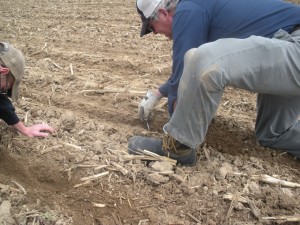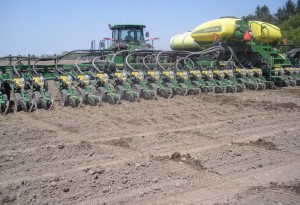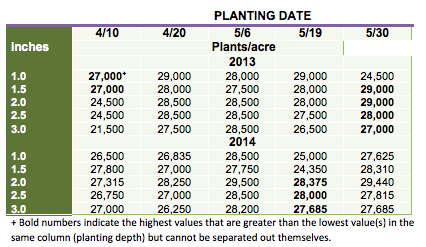Bill Cox, Section of Crop and Soil Sciences, Cornell University

Most agronomists agree that a ~2.0 inch planting depth is usually optimum for corn establishment in northern latitudes that receive ample rainfall during the spring. A shallower planting depth, especially less than 1.5 inches, may lead to early-season root lodging associated with shallow nodal root development or corn injury from pre-emergence herbicides. In addition, a planting depth of less than 1.5 inches or less when soil conditions are dry could result in drying out of the seed, thereby reducing emergence or delaying emergence until precipitation alleviates the dry soil conditions. Planting deeper than 2.0 inches may delay emergence, especially when planting under cool conditions in April or early May. Also, planting deeper than 2.0 inches may reduce emergence because of crusting problems, especially on heavier clay soils, or pest problems, associated with the delayed emergence.

We conducted a hybrid x planning date x seeding depth study at the Aurora Research Farm in 2013 and 2014. We planted two corn hybrids on five dates from early April through late May at seeding depths of 1.0, 1.5, 2.0, 2.5, and 3.0 inches. In addition, we conducted field-scale studies with four corn growers who planted corn at four seeding depths (1.0, 1.5, 2.0, and 2.5 inches). We will share with you the early plant populations taken at the 4th leaf stage (V4), about 3 to 7 weeks after planting (depending upon planting date), in each study. We will eventually run regression analyses on the data but in this news article we will just observe trends in the data, based on an ANOVA analyses.

A planting date x seeding depth interaction was observed for days to emergence as well as plant populations at the V4 stage for both years in the small plot study at Aurora (Tables 1 and 2). The deeper planting depths, especially the 3.0 planting depth, required 2 to 4 additional days for emergence on the April planting dates in 2013 and 1.25 to 2.25 additional days in 2014. The 1.0 inch depth however, required an additional 1 to 1.75 days for emergence for the May planting dates in 2013 and an additional 0.75 days for the late May planting date in 2014. Obviously, cool conditions delayed emergence at the 3.0 inch depth for the April planting dates and dry soil conditions probably delayed emergence at the 1.0 inch planting depth for May planting dates in 2013 and the late May planting date in 2014.

Delayed emergence at the 2.0, 2.5 and 3.0 inch depths affected plant populations on the early April planting date in 2013 (Table 2). Compared with the 1.0 and 1.5 inch depths, the 2.0 and 2.5 inch depths had 2500 fewer plants/acre and the 3.0 inch planting depth had 6500 fewer plants/acre. Plant populations among seeding depths, however, did not differ for most other planting dates in both years, except for the late May planting date in 2013 and the mid-May planting date in 2014. On both those planting dates, the 1.0 inch planting depth had ~4000 fewer plants/acre compared with the 2.0 inch planting depth. Overall, the 1.5 to 2.0 inch planting depth mostly had the highest plant populations with the exceptions being the 2.0 inch depth too deep for the early April planting date in 2013 and the 1.5 inch depth being too shallow for the late May planting date in 2013 and mid-May planting date in 2014.
Despite the planting date x seeding depth interaction for days to emergence and plant populations in 2013, yield did not have a planting date x seeding depth interaction (What’s Cropping Up?, vol.24, no.1, 2014, p.7-8). The 1.5 and 2.0 inch seeding depths, however, did have a significant 4% yield advantage when compared with the 2.5 and 3.0 inch seeding depths but yielded the same as the 1.0 inch seeding depth. Wet spring conditions prevailed in 2013 (3.6 inches of May precipitation), however, so soil conditions did not become dry in the top 1.0 inch until late May, which contributed to the similar yield at the 1.0, 1.5, and 2.0 planting depths in 2013. Wet spring conditions prevailed again in 2014 (4.2 inches of precipitation in May), which again negated a reduction in plants/acre on most planting dates. Root lodging did not occur in this study in 2013.

Growers at three of the sites in the field-scale studies had new planters in 2013 so depth control and seed metering were optimum. Nevertheless, plant populations had year x location x seeding depth interactions in the field-scale studies, illustrating that the optimum planting depth depends equally upon soil conditions at and shortly after planting as the actual planting depth itself (Table 3). The Cayuga County site, a well-drained silt loam soil in both years, had ideal conditions at planting (moist at planting and a light shower after planting) in 2013 and plant populations (and yield) did not differ among seeding depths. In 2014, however, dry conditions prevailed for 10 days after planting at the Cayuga Co. site and the 1.0 inch seeding depth had ~ 3000 fewer plants/acre compared with the other seeding depths. At Livingston County, pre-emergence herbicide injury resulted in severe damage to stand establishment in 2013 (~2.0 inch rainstorm shortly after planting) greatly reducing plant populations (and yield). In 2014, dry conditions prevailed for 2 weeks after planting and the 1.0 inch depth had more than 6000 fewer plants/acre compared with the 2.0 and 2.5 seeding depths. Obviously, the grower will not plant below the 2.0 inch depth at this site in the future.
Dry conditions also prevailed for 15 days after planting on the silty clay loam soil at the Orleans Co. site in 2013 resulting in ~2000 fewer plants/acre (and 12 bushel/acre lower yield) at the 1.0 inch compared with the 2.0 and 2.5 inch seeding depths. In 2014, a torrential downpour occurred within minutes of planting at Orleans Co. The silty clay loam soil at this site apparently developed significant soil crust upon drying, which contributed to 2000 to 4000 fewer plants/acre at the 2.0 and 2.5 inch depths compared with the 1.0 inch depth. Likewise, in 2013 at the Seneca Co. site, torrential rainstorms (3.0 inches) occurred a few days after planting resulting in significant crusting upon drying on this clay loam soil, which contributed to ~2500 to 6000 fewer plants/acre (and 10-15 fewer bushels/acre) at the 2.0 and 2.5 inch depths compared with the 1.5 inch depth. In 2014, dry conditions prevailed after planting but this no-till site had ample moisture in the top inch for similar emergence rates as from the deeper soil depths. Root lodging was not observed at the 1.0 inch depth at any sites in 2013.
In closing, soil conditions play an equal role as seeding depth does for corn stand establishment. Generally, planting depth should be shallower on heavier soils but not always as indicated by the 2.0 and 2.5 inch depths having the greatest plant populations because of dry conditions after planting at Orleans Co. in 2013. The 1.0 inch planting depth is usually too shallow because of dry soil conditions (Orleans Co. in 2013 and Cayuga and Livingston Co. in 2014 or can result in herbicide damage to the shallow-planted seed at Livingston Co. in 2013). On the other hand, torrential rains after planting can reduce plant populations, especially on heavier clay soils (Seneca Co. in 2013 and Orleans Co. in 2014). Overall, the 1.5 inch seeding depth provided the most consistent plant populations in the field-scale studies (but yields were higher at the 2.0 and 2.5 inch depths at Livingston and Orleans Co. in 2013). Once we get the yield data from 2014 we will summarize our findings. Based on the plant population data, there does not appear to be a “one size fits all optimum seeding depth” and the optimum seeding depth depends equally on soil and weather conditions as actual planting depth.

